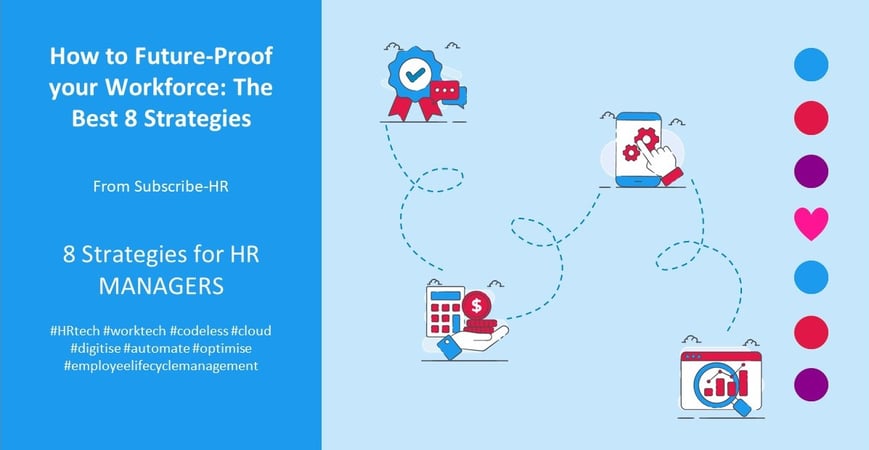According to SHRM, 83% of HR professionals experience difficulty recruiting qualified candidates. At the same time, Millennials are expected to make up 75% of the workforce by 2030.
It’s clear that many shifts are happening in the very fabric of our workforces – and this requires HR leaders to be proactive in the way they approach change.
But how can you future-proof your workforce to equip your employees with the skills, knowledge, and mindset to adapt and thrive despite these changes? Let’s explore! 🔍

Why should you future-proof your workforce?
Future-proofing your workforce essentially empowers employees to adapt to evolving technologies and industry trends.
When HR departments invest in skills development and provide opportunities for continuous learning, they’re able to equip their employees with the tools they need to remain relevant in the face of change.
Enhancing job security and loyalty
As a result, employees feel more secure in their roles, knowing that they have the skills and knowledge to navigate the challenges of the future. This increased sense of security fosters loyalty among employees, reducing turnover rates and creating a more stable workforce.
Boosting productivity through innovation
Additionally, automation, AI, and other technological advancements streamline processes, eliminate manual tasks, and reduce the likelihood of errors. This not only frees up time and resources but also allows employees to focus on more strategic and value-added activities. As a result, productivity levels soar, and organisations can achieve their goals more effectively and efficiently.
Staying ahead of market trends
Future-proofing initiatives enable organisations to continuously update their skills and capabilities in response to changing market dynamics. This agility allows businesses to anticipate customer needs, identify emerging trends, and pivot their strategies accordingly.
Cultivating an innovative environment
At the heart of future-proofing efforts lies a culture of continuous learning and innovation. Employees are encouraged to take risks, challenge the status quo, and pursue new ideas. This culture of innovation not only keeps organisations ahead of the curve but also attracts top talent who are eager to be part of a dynamic and forward-thinking workplace.
Prioritising employee development
Investing in employee development is not only essential for future-proofing but also for attracting and retaining top talent. In today's competitive job market, employees are looking for more than just a paycheck—they want opportunities for growth and advancement. Future-proofing initiatives signal to employees that their professional development is a priority for the organisation.

8 Winning Strategies to Future-Proof your Workforce
1. Invest in HR technology
Modern HR technology solutions encompass a wide array of tools and platforms designed to streamline various HR processes, from recruitment and onboarding to performance management and training.
These technologies automate repetitive tasks, improve data accuracy, enhance employee experience, and provide valuable insights for informed decision-making.
When you implement advanced tools such as applicant tracking systems (ATS), learning management systems (LMS), and performance analytics platforms, you’ll be able to optimise your HR processes, stay ahead of the curve, and ensure that your workforce remains agile and adaptable in the face of technological advancements.
Some examples of HR tech you can leverage for future-proofing your workforce are ⬇️
Applicant Tracking Systems (ATS)- Streamline recruitment processes
- Enhance candidate experience
- Analyse recruitment metrics
- Centralise training and development resources
- Track employee progress and completion
- Personalise learning paths
- Facilitate ongoing performance feedback and goal-setting
- Automate performance reviews and evaluations
- Provide real-time performance insights
- Create a comprehensive skills inventory
- Identify skills gaps and develop targeted training programs
- Match employees with internal opportunities
- Measure employee satisfaction and engagement
- Identify factors influencing employee engagement
- Foster a culture of recognition and appreciation
- Analyse workforce data to forecast talent needs
- Optimise workforce planning strategies
- Align workforce planning with organisational goals
- Facilitate seamless communication and collaboration - Slack
- NPS and Pulse Surveys
- Announcements and Acknowledgement and other Surveys for Employees

2. Create a skills framework
A robust skills framework serves as the cornerstone of your future-proofed workforce. It involves identifying and defining the key competencies and skills required for current and future roles within the organisation.
This framework provides a clear roadmap for talent development and management, enabling organisations to assess their workforce's capabilities, identify skills gaps, and develop targeted training programs to bridge those gaps effectively.
When you align job roles with specific skills and competencies, you can ensure that employees understand the skills required to succeed in their roles and provide them with opportunities for career growth and advancement within your organisation.
3. Integrate your job architecture into your skills framework
It's essential to integrate it with your organisation's job architecture to maximise the effectiveness of your skills framework.
Job architecture refers to the systematic structuring of job roles within an organisation, including job titles, hierarchies, and career paths.
When you map job roles to specific skills and competencies outlined in the skills framework, you can identify skills requirements for each role, assess employee proficiency, and facilitate internal mobility and career progression.
This integration ensures alignment between talent management processes and organisational goals, enabling you to optimise workforce planning, succession management, and performance evaluation processes.
For example:
Identifying the skills required for each role
Suppose your organisation is implementing a new customer relationship management (CRM) system. By mapping job roles within the sales department to specific skills and competencies required to effectively utilise the CRM system, you can identify the skills needed for each sales position.
For example, a sales manager might require advanced proficiency in data analysis and reporting, while a sales representative might need strong communication and customer service skills.
Assess employee proficiency
After mapping job roles to skills and competencies, you can assess employee proficiency levels to determine if there are any skills gaps within the organisation.
For instance, through skills assessments and performance evaluations, you may discover that certain sales team members lack the technical skills needed to leverage the new CRM system effectively. Identifying these gaps allows you to provide targeted training and development opportunities to bridge the gap.
Facilitate internal mobility
Once you have identified skills requirements for each role and assessed employee proficiency, you can facilitate internal mobility and career progression within the organisation.
For example, if a sales associate demonstrates a strong aptitude for data analysis and reporting during skills assessments, they may be considered for promotion to a sales manager role responsible for overseeing CRM utilisation strategies. This internal mobility not only benefits individual employees by offering opportunities for career advancement but also strengthens the organisation by leveraging existing talent.
Align talent management processes with organisational goals
Integrating your skills framework with your job architecture ensures alignment between talent management processes and organisational goals.
For instance, if one of your organisation's strategic objectives is to improve customer satisfaction through enhanced sales performance, mapping sales roles to skills and competencies related to customer relationship management aligns talent management efforts with this goal.

4. Link your skills framework to your current processes
To ensure the seamless integration of your skills framework into your organisation's existing HR processes, it's crucial to link it with your current talent management processes.
Linking your skills framework to existing processes ensures consistency and alignment across the organisation. This integration allows organisations to identify skill requirements for specific roles, assess employee proficiency, and tailor development plans to address skills gaps effectively.
Some applications of this include ⬇️
- Recruitment process
- Incorporate the skills framework into job postings to clearly outline the required skills, competencies, and qualifications for each role
- During the interview process, assess candidates' proficiency in key skills and competencies outlined in the framework through targeted questions, skills assessments, and practical exercises. This ensures that selected candidates possess the necessary skills to excel in their roles and contribute to the organisation's success from day one
- Performance management
- Use the skills framework as a basis for evaluating employees' performance by aligning key competencies with performance metrics and goals relevant to their roles
- Provide employees with targeted feedback and development opportunities based on their proficiency levels in specific skills and competencies outlined in the framework. This personalised approach to performance management helps employees improve in areas where they may be lacking proficiency, ultimately driving individual and organisational success
- Learning and Development
- Identify skill gaps within the organisation by comparing employees' current skill levels against the skills and competencies outlined in the framework
- Tailor learning and development programs to address identified skill gaps effectively, ensuring that training initiatives are aligned with the organisation's strategic objectives and contribute to employees' professional growth and development. By focusing on relevant skill development, organisations can optimise the impact of training initiatives and empower employees to succeed in their roles
- Talent acquisition and retention
- Leverage the skills framework to attract top talent by clearly articulating the required skills and competencies for each role in job postings and recruitment materials.
- Address skill gaps proactively through targeted development plans and career advancement opportunities, demonstrating a commitment to employees' professional growth and enhancing retention rates.
5. Analyse the cost implications
Future-proofing your workforce requires a significant investment of resources, both in terms of time and money. It's essential to conduct a comprehensive cost-benefit analysis to evaluate the financial implications of implementing future-proofing strategies and assess the potential return on investment (ROI).
This analysis involves identifying the costs associated with training, technology implementation, and process optimisation, as well as estimating the potential benefits in terms of increased productivity, improved employee engagement and reduced turnover rates.
Ultimately, when you understand the cost implications of future-proofing initiatives, you can prioritise relevant investments, allocate resources effectively, and ensure that your future-proofing efforts align with long-term organisational goals and objectives.

6. Leverage data for better talent decisions
Data-driven decision-making is essential for future-proofing your workforce. We recommend leveraging advanced data analytics tools and techniques so that you can gain valuable insights into workforce trends, identify skill gaps, and make informed talent decisions.
This involves analysing workforce data to predict future talent needs, assess the effectiveness of training programs, and measure employee engagement and performance.
Other data you can leverage for better talent decisions includes 👇
- Employee performance reviews
- Key performance indicators (KPIs)
- Sales targets and quotas
- Customer satisfaction ratings
- Skills assessments
- Training and certification records
- Proficiency levels in specific tools or technologies
- Competency evaluations
- Employee satisfaction surveys
- Feedback from pulse surveys
- Employee Net Promoter Score (eNPS)
- Participation rates in company events and initiatives
- Application and resume data
- Applicant tracking system (ATS) metrics
- Time-to-hire and cost-per-hire metrics
- Candidate feedback and interview performance
- Employee turnover rates
- Reasons for attrition (exit interviews)
- Employee tenure and loyalty metrics
- Retention program effectiveness metrics
- Talent mobility and career progression data
- Leadership readiness assessments
- Bench strength and talent pipeline metrics
- Demographic data (gender, ethnicity, age)
- Representation of diverse groups in leadership positions
- Employee resource group participation
- Diversity training participation and effectiveness
- Workforce demographics and trends
- Labour market data and industry benchmarks
- Workforce planning scenarios and projections
- Predictive analytics for future talent needs
- Training completion rates
- Skills acquisition and proficiency improvement
- ROI of learning and development initiatives
- Employee career development plans and goals
7. Foster a culture of continuous learning — upskill and reskill
Today’s workforce calls for organisations to foster a culture of continuous learning and development, empowering employees to upskill and reskill to meet changing job requirements and market demands.
This involves providing access to a wide range of learning opportunities, including online courses, workshops, seminars, and mentorship programs. Organisations can also encourage employees to take ownership of their learning journey, set personal development goals, and pursue certifications and qualifications relevant to their roles.
When you prioritise continuous learning and development, you can create a culture where learning is valued, innovation is encouraged, and employees are equipped with the skills and knowledge needed to thrive in a rapidly changing environment.

8. Embrace the remote and hybrid work model
The COVID-19 pandemic has accelerated the adoption of remote and hybrid work models, presenting both opportunities and challenges for organisations. Embracing remote and hybrid work allows organisations to access a broader talent pool, improve employee flexibility and work-life balance, and reduce operational costs associated with office space and facilities.
However, transitioning to remote and hybrid work requires careful planning and investment in technology infrastructure, communication tools, and employee training. Organisations must also establish clear policies and procedures to ensure effective remote collaboration, maintain team cohesion, and support employee well-being.
FAQs – Frequently Asked Questions
What are future-proofing strategies?
Future-proofing strategies are proactive measures taken by organisations to anticipate and adapt to future changes in the workplace. These strategies involve investing in technologies, developing employee skills, and fostering a culture of continuous learning to ensure long-term success and sustainability.
How do you prepare your workforce for the future?
To prepare your workforce for the future, it's essential to invest in training and development programs that focus on emerging technologies, market trends, and evolving industry requirements. Additionally, fostering a culture of innovation, adaptability, and continuous learning can empower employees to navigate and thrive in a rapidly changing landscape.
How do I make my company future proof?
Making your company future-proof requires a strategic approach that encompasses various aspects of the business, including technology adoption, talent development, and market agility. By embracing digital transformation, investing in employee skills development, and staying attuned to market trends, you can ensure that your company remains competitive and resilient in the face of change.
What are some examples of future-proofing strategies in the workplace?
Examples of future-proofing strategies include implementing digital transformation initiatives, offering continuous learning and development opportunities to employees, investing in emerging technologies, and fostering a culture of innovation and adaptability.
What are the methods of future-proofing a business?
Methods of future-proofing a business involve identifying potential risks and opportunities, staying abreast of industry trends and technological advancements, diversifying revenue streams, building a resilient workforce, and proactively addressing challenges through strategic planning and agility.
Why is future-proofing important for organisations?
Future-proofing is important for organisations to ensure their long-term viability, competitiveness, and sustainability in an increasingly dynamic and unpredictable business environment. By anticipating and adapting to future changes, organisations can minimise risks, capitalise on emerging opportunities, and maintain their relevance and success over time.
What is the meaning of future-proof organisation?
A future-proof organisation is one that has implemented strategies and practices to adapt and thrive in the face of future challenges and uncertainties. It is agile, innovative, and forward-thinking, with a resilient workforce, adaptable processes, and a culture that embraces change and continuous improvement.
How can future-proofing education benefit individuals and organisations?
Future-proofing education involves equipping individuals with the skills, knowledge, and competencies needed to succeed in a rapidly changing world. By investing in education and skills development, individuals can enhance their employability, adaptability, and career prospects, while organisations can build a skilled workforce capable of driving innovation and growth.
What role does continuous learning play in future-proofing the workforce?
Continuous learning is essential for future-proofing the workforce as it enables individuals to acquire new skills, stay updated on industry trends, and adapt to evolving job requirements. By fostering a culture of lifelong learning, organisations can empower employees to thrive in a dynamic and competitive business landscape.
What are the key skills required for future-proofing the workforce?
Key skills for future-proofing the workforce include digital literacy, critical thinking, adaptability, problem-solving, creativity, emotional intelligence, and collaboration. These skills enable employees to thrive in a rapidly changing workplace and contribute to organisational success.
How can organisations leverage data analytics for future-proofing their workforce?
Organisations can use data analytics to identify skills gaps, predict future talent needs, assess workforce performance, and tailor learning and development programs to address specific needs. By leveraging data insights, organisations can make informed decisions to optimise talent management strategies and enhance workforce effectiveness.
What are the benefits of embracing remote work and hybrid work models for future-proofing the workforce?
Embracing remote work and hybrid work models can future-proof the workforce by enhancing flexibility, promoting work-life balance, and expanding access to talent beyond geographic boundaries. These models also enable organisations to adapt to disruptions such as pandemics, natural disasters, and technological changes, ensuring business continuity and resilience.
How can organisations foster a culture of continuous learning to future-proof their workforce?
Organisations can foster a culture of continuous learning by providing access to learning resources and opportunities, encouraging knowledge sharing and collaboration, recognising and rewarding learning achievements, and promoting a growth mindset across the organisation.

